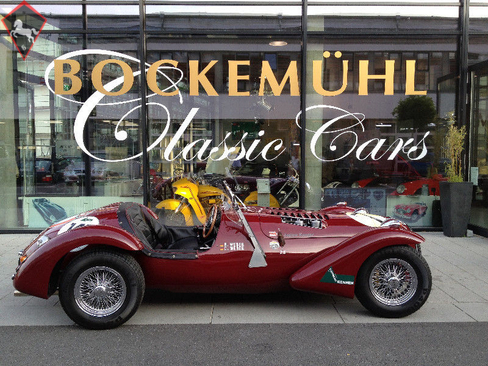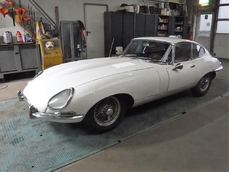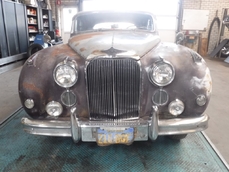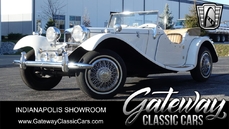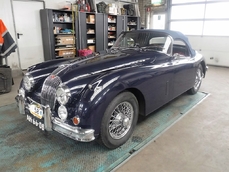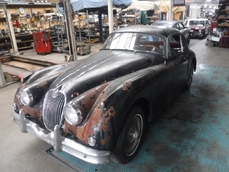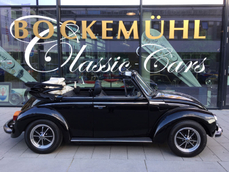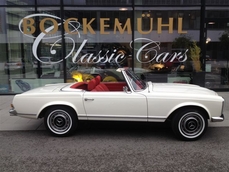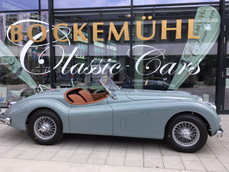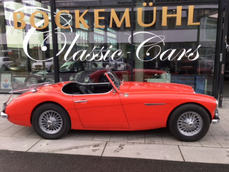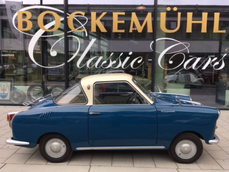Jaguar Other Sports 1970
General description :
Sehr seltener und schöner Sport-Roadster im Stil der 50er und 60er Jahre Monoposti.
Es handelt sich um ein Original-Fahrzeug, keine Replica.
Ein Wertgutachten mit NOTE 1- vom Juli 2015 liegt vor.
Das Fahrzeug hat nur zwei Vorbesitzer und entstammt dem Privatmuseum eines englischen Landlords.
Laut aktuellem Besitzer ist es unrestauriert und unverändert und nur zwei in Deutschland zugelassene Werksbau Kougar Sports bekannt. Insgesamt wurden lediglich ca. 315 Fahrzeuge dieses Typs gebaut.
Der Kougar Sports ist ein auf Jaguar E Basis aufgebauter Special in welchem der berühmte 3,8 ltr. Motor mit C-Kopf (verbesserter Serienkopf) verbaut wurde. Mit dieser Optimierung und in Verbindung mit einer Transitor-Zündanlage, zwei Mitsuba-Rennpumpen, einer Dreifach-Vergaseranlage und einer speziellen Edelstahl-Auspuffanlage, leistet dieser Motor 265 PS.
Aufgrund der langen Standzeit im Museum wurde der Motor beim km-Stand von 5.766 km komplett zerlegt und neu aufgebaut.
Das Fahrzeug ist auf einem Gitterrohrahmen mit Einzelradaufhängung aufgebaut. Es handelt sich um einen Rechtslenker mit Rennsitzen, 4-Gang-Schaltgetriebe mit Overdrive und verchromten Speichenfelgen mit Zentralverschluss.
Dieser Kougar Sports präsentiert sich bezüglich Karosserie und Lack, Motor und Technik, Interieur und Anbauteilen in einem ausgezeichneten zustand.
Das Fahrgeräusch und die Fahrdynamik sind begeisternd und haben Suchtpotential.
Standort im Areal der MOTORWORLD Region Stuttgart (Böblingen).
Verkauf im Kundenauftrag, MwSt. nicht ausweisbar, differenzbesteuert.
Zwischenverkauf, Irrtum und Schreibfehler vorbehalten.
1970 Jaguar Other Sports is listed for sale on ClassicDigest in Graf Zeppelin Platz 1 (MOTORWORLD)DE-71034 Böblingen by BOCKEMÜHL Classic-Cars, Holger Bockemühl for €67000.
Car Facts
Car type : Car Make : Jaguar Model : Other Model Version : Sports Engine size : 3.8 Model Year : 1970 Sub type : Convertible Location : Graf Zeppelin Platz 1 (MOTORWORLD)DE-71034 Böblingen Vehicle Registration : Undefined
67000 €
Seller Information
BOCKEMÜHL Classic-Cars, Holger Bockemühl
BOCKEMÜHL Classic-Cars, Holger Bockemühl
+49 (0)7031 209745363
BOCKEMÜHL Classic-Cars, Holger Bockemühl
+49 (0)7031 209745363
People who viewed this Jaguar Other also viewed similar Jaguar listed at ClassicDigest
Other cars listed for sale by this dealer
About Jaguar
Ah, the story of Jaguar, from its early days as the SS Cars Ltd. to its pinnacle with the D-type, and the street-going evolution in the form of the iconic E-type. There's something quintessentially British about this tale, and I'll narrate it as a British journalist might.In the Beginnings:
Our journey into the world of Jaguar begins in the 1930s, when a company known as SS Cars Ltd. emerged. Despite the unfortunate coincidence of their initials with the rising political tensions in Europe, they started producing stylish and performance-oriented cars. The SS 100, introduced in 1936, was a symbol of elegance and speed, setting the stage for what would become Jaguar.
The Birth of Jaguar:
As the shadows of World War II loomed, SS Cars Ltd. wisely decided to disassociate themselves from the SS initials. Thus, in 1945, they officially became Jaguar Cars Ltd., a name that would soon be synonymous with British luxury and performance.
The XK Series:
Jaguar's post-war era brought us the XK 120, a true sensation in 1948. With its sleek design and a powerful 3.4-liter inline-six engine, it became the world's fastest production car. The XK 120 was the blueprint for what lay ahead – Jaguars that blended style with speed in a uniquely British fashion.
The D-type Dominance:
Then came the D-type, a true racing legend. Introduced in 1954, it won Le Mans three times in the 1950s, showcasing Jaguar's engineering prowess. With its innovative monocoque construction and the iconic fin at the back, the D-type was the apex of Jaguar's motorsport success.
The E-type Emergence:
But the true turning point arrived in 1961 with the introduction of the E-type, often described by Enzo Ferrari as "the most beautiful car ever made." Its long bonnet, curvaceous body, and a 3.8-liter engine delivering exhilarating performance made it an instant classic. The E-type was not just a car; it was a work of art on wheels, and it could hit 150 mph on the road.
Street and Racing Success:
The E-type's beauty was matched by its capability on the track. The lightweight E-types were particularly successful in various racing events, cementing Jaguar's reputation as a force to be reckoned with in motorsport.
The Age of Refinement:
As we delve deeper into the Jaguar story, we find that the 1950s and 1960s were an age of refinement and expansion. Alongside the magnificent D-type and the E-type's iconic emergence, Jaguar introduced models that further solidified its reputation for luxury and performance.
The MK2:
In the late 1950s, Jaguar unveiled the MK2, a sports sedan that combined elegance with power. This sleek four-door saloon was a favorite of bank robbers and law enforcement alike, thanks to its exceptional speed and handling. The MK2 was a symbol of Jaguar's ability to blend sophistication with performance and had a successful racing career as well.
The XJ6:
Fast forward to 1968, and Jaguar launched a car that would define luxury saloons for decades to come – the XJ6. It was a masterpiece of engineering and design, featuring a smooth inline-six engine, independent rear suspension, and a spacious, beautifully appointed interior. The XJ6 was a symbol of British elegance and provided a ride so smooth that it seemed to glide over the road. It became the flagship model for Jaguar and set the standard for luxury saloons, showcasing a level of refinement that left competitors in awe.
The Blend of Classic and Modern:
While the MK2 and XJ6 represented the evolution of Jaguar's saloon cars, they maintained the brand's commitment to performance and luxury. These cars didn't just belong on the racetrack; they were equally at home cruising down the grand boulevards or gliding through the English countryside.
The Challenges of Change:
However, as the 1970s arrived, Jaguar, like many British automakers, faced financial challenges and changes in ownership. The British Leyland era brought both opportunities and struggles, as the brand navigated through various mergers and transitions.
Nevertheless, the legacy of the MK2 and XJ6, along with the D-type and E-type, continues to define Jaguar as a manufacturer that combines timeless elegance with a spirit of performance. These classic models, whether driven on winding roads or parked as collectors' treasures, serve as a testament to Jaguar's enduring presence in the world of automotive excellence.
The Jaguar story, from its early days as SS Cars Ltd. to the creation of automotive icons like the E-type, MK2, and XJ6, is a journey that reflects the very essence of British motoring – a blend of luxury, power, and style that continues to captivate enthusiasts and connoisseurs alike.
